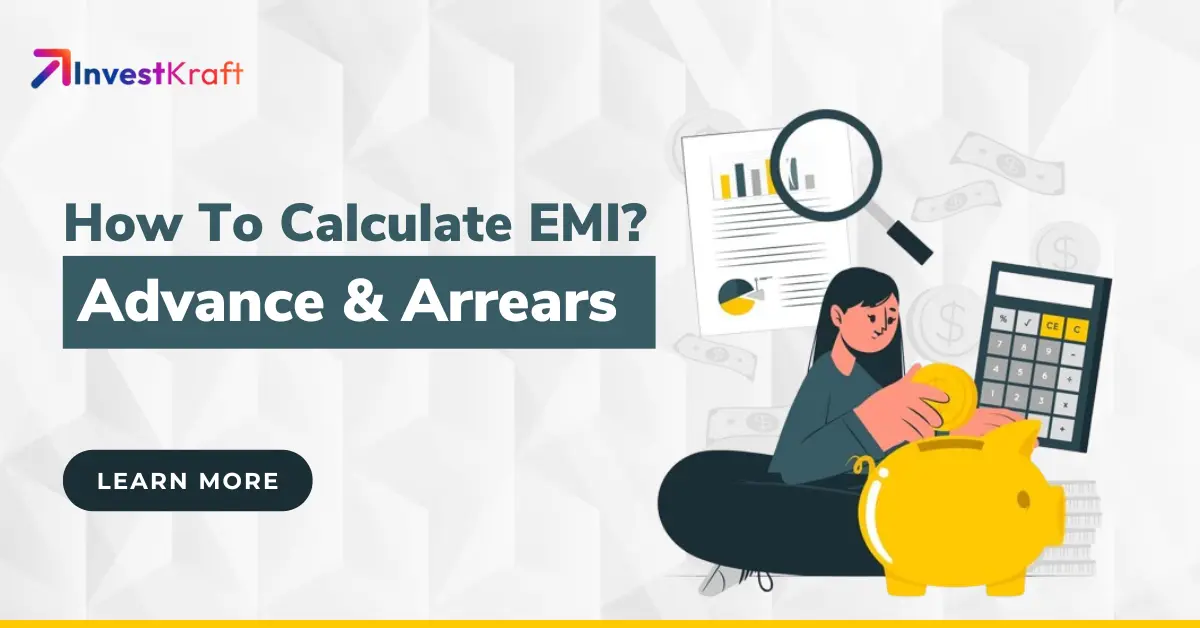How To Calculate EMI In Advance And EMI In Arrears?

How To Calculate EMI In Advance And EMI In Arrears? In the field of loans, the borrowed amount is primarily repaid in the form of a monthly payout which is known as an Equated Monthly Instalment (EMI). These installments are paid by the borrower for a fixed period that is decided at the time of loan application and approval. The importance of EMIs is paramount as everyone can't repay the loan amount in one go. EMIs are beneficial for both the borrower and the lender. The lender can choose to seek benefit by applying the decided interest rate on the principal amount and receive the finalized amount at regular intervals in the form of EMI. On the other hand, a borrower finds it easy to pay the loan amount in smaller parts known as the EMIs.
If you are looking to borrow a loan, it is advisable to use various EMI calculators available online that can help you strike a perfect balance between your monthly income and expenses. In general, when it comes to repaying a loan, a majority of banks and financial institutions offer two repayment options to borrowers – EMI IN ADVANCE and EMI IN ARREARS. You will get to know both of them in the following part of this post. So, let’s check them out.
Advance EMI
What is Advance EMI? Also known as Advance EMI, an EMI in Advance is considered a repayment option where a borrower pays the first EMI in advance to the money lender. In this type of repayment setting, the principal loan amount minus the processing charges and the first EMI amount is disbursed to the borrower’s bank account. And, the first EMI deducted in advance EMI option consists of just the principal amount which therefore helps in reducing the principal loan amount for the leftover EMIs. Once the first EMI is paid by the borrower, the rest of the EMIs will be inclusive of both the principal amount and the applicable interest.
EMI In Arrears
It is the most preferred loan repayment option by lenders these days. Therefore, it is also known as standard EMI. In this kind of repayment scheme, the borrowers are supposed to pay their EMIs on a fixed date over some time. In this instance, the loan processing charges will be deducted from the principal loan amount before the lender disburses the loan funds into the bank account of the borrower. If the borrower is not able to pay the first EMI in full, this is undoubtedly the perfect repayment option for you.
How To Calculate Advance EMI And EMI In Arrears?
The best way to figure out the amount that will go out in both EMI cases is to look at this example. How are EMIs Calculated and what makes the two different? For example, if you come across a financial need of 4.5 lacs and want to take a loan to fulfil the same through a bank or NBFC. Now, you get a lender who is offering you a personal loan amounting to 3 lacs with a 12% annual interest rate for a period of 3 years (36 months) and Rs. 3, 000 as a processing fee.
-
The amount that is required – Rs. 4.5 lacs
-
Approved loan amount - Rs. 3 lacs
-
Interest rate – 12%
-
Loan period – 36 months (3 years)
-
Loan processing charges – Rs. 3,000
|
EMI Option |
EMI value (Rs) |
Disbursed Loan Amount (DLA) |
Down Payment (DP) |
Total Loan Cost (DP+EMI+No. of leftover EMIs) |
|
EMI in Advance |
Rs. 9866 |
Loan amount - 3, 00, 000 |
Amount required - 4, 50, 000 |
Rs. 1, 62, 866 + (Rs. 9866*35) = Rs. 5, 08, 176 |
|
EMI in Arrears |
Rs. 9964 |
Loan amount - 3, 00, 000 |
Amount required - 4, 50, 000 |
Rs. 1, 53, 000 + (Rs. 9964*36) = Rs. 5, 11, 704 |
|
Difference |
Rs. 98 less |
Rs. 9866 less |
Rs. 9866 more |
Rs. 3528 less |
From the above table, you can easily understand how much amount you would pay towards the borrowed amount in both scenarios – EMI in Advance and EMI in Arrears. However, for better clarification of both scenarios, it is advisable to contact the lender before signing the loan agreement.
EMI in advance vs EMI in arrears What To Choose?
According to loan experts, both the options - Advance EMI and the Arrears EMI repayment options are fine, however, the selection of a specific option largely depends on the borrower’s financial circumstances. For instance, use an arrears EMI plan if your budget is not sufficient since you will be at ease and won’t stay away from the burden of making the first down payment. If you don't have any financial hindrances, it is better to pay the advance EMI because it would lower the principal loan amount.
Factors Affecting EMI Calculation
EMI or equated monthly instalments may not remain constant despite its name. When applying for a loan, you calculate your EMI based on a fixed loan amount, interest rate and tenure. However, several factors can cause your EMI to change. It is important to understand these reasons.
- Interest Rate Changes During Loan Tenure: Interest rates on loans can vary throughout the loan term, affecting borrowers in different ways depending on the type of interest rate chosen. Various lenders, such as banks, offer different interest rates on loans, including different types of rates. Changes in general interest rates can also impact the equated monthly instruments of borrowers.
EMI on floating rate loan changes with interest rate. Home loan rate changes with RBI’s bank rate change. Fixed-rate loans may not be affected. Few banks offer fixed rates. Floating rate loans may have changed EMI or loan tenure.
- Extra Payments/Prepayments Allowed on Principal: Banks allow early repayment of loans through lump sum payments. Extra payments reduce the outstanding amount and the interest burden. Lenders may charge a penalty of 1 to 3% on the remaining amount, but some waive it for prepayments up to 25% of the loan amount in a year. Penalties may vary based on the reasons and source of funds.
- Prepaying the Loan Depends: If the interest is higher than returns from investments, pre-close the loan. You will be debt-free and have peace of mind. Some banks may waive the prepayment penalty if using your funds.
- Change in Loan Duration: Negotiating a new loan term with your lender or switching to a new lender with a different loan term will result in a change in your EMI amount. If the loan tenure is longer, your monthly EMI payment will decrease. On the other hand, a shorter loan tenure will result in a higher EMI burden but will allow you to repay the loan faster. However, longer tenures will lead to paying more interest, making the loan more expensive in the long run.
- Flexible Loan Repayment Options: Financial institutions offer flexible repayment options with unequal EMIs. Step-up loans have initially low EMIs that increase over time, while step-down loans have initially higher EMIs that decrease over time. Step-up loans are convenient for borrowers at the beginning of their careers, while step-down loans are useful for borrowers nearing their retirement.
Importance of Choosing the Right EMI Structure
- Choosing the right EMI structure is crucial for managing your budget effectively and avoiding financial strain. The structure determines the amount repaid monthly, including principal and interest.
- Consider EMI impact on cash flow. Assess income stability and obligations. Choose a flexible plan for financial safety.
- Opt for EMI structure based on loan tenure to balance lower EMIs and higher interest for longer tenures, and higher EMIs with lower interest for shorter tenures.
Choosing the right EMI structure is crucial. It impacts the monthly budget, interest outgo, cash flow, and loan duration. Evaluating factors like income stability, goals, and interest helps make informed decisions for cost-effective repayment.
FAQs
1. What Happens If The Interest Rates Are Fixed Or Floating?
-: In the case of a floating interest rate, choosing EMI in Advance option seems a feasible one for most borrowers.
2. I Don’t Have Sufficient Money For Down Payment. Which Option Would Be Better?
-: The best alternative for borrowers who lack the money to make a down payment on a loan is an EMI in arrears. This is because you simply have to make the instalment every month and the entire loan amount, less the processing costs, will be disbursed.
3. Under Which EMI Option, My Down Payment Would Be Higher?
-: Your down payment would be higher in the case of the EMI in Advance option.
The Conclusion
If you are looking to avail a loan and are confused between EMI in advance and EM in arrears in Delhi, you can refer to different types of EMI calculators available online. Almost every loan service provider and other portals feature these calculators. By using them, you can determine which EMI option you should opt for while taking a loan.
Verify Phone Number
Related Post

Top 20 Affiliate Marketing Programs in India 2026
Some people are quietly making ₹25,000… ₹50,000… even ₹1 lakh+ per month just by sharing links...
Read more...
Top 15 Work From Home Jobs in India 2026
If you are searching for work-from-home jobs in India, or ways to earn ₹1,000 per day working from h...
Read more...
Best Investment Options, Plans & Strategies in India 2026
Across India, beginners, salaried people, businessmen, students, and even retired individuals...
Read more...
Peer-to-Peer (P2P) Lending in India: Complete 2025 Guide to Risk, Returns, RBI Rules & Best Platforms
Peer-to-peer lending, also known as P2P lending, is when one individual lends money to another...
Read more...
Top 10 P2P Lending Companies in India 2026 (RBI Registered NBFC-P2P Platforms)
Peer-to-peer lending, commonly known as P2P lending, has become one of India’s fastest-growing...
Read more...
Top 10 Microfinance Companies in India – List, Benefits & RBI Updates
Microfinance institutions (MFIs) play a pivotal role in promoting financial inclusion in India...
Read more...
10 Best Foreign Banks in India 2025: Complete List with Features & Services
Foreign Banks in India play a very important role in offering world-class financial services,...
Read more...
Top Private Sector Banks in India 2026: List, Strengths, Services & Key Updates
Private sector banks in India have played a very important role in the country's financial sce...
Read more...
Top 10 Government Banks in India 2026: A Comprehensive Guide
Government banks, also known as Public Sector Banks (PSBs), form the backbone of India’s banki...
Read more...
Top Regional Rural Banks in India 2025–2026: List, Strengths, Benefits & Updates
Regional Rural Banks (RRBs) play a vital role in India’s rural and semi-urban financial ecosys...
Read more...Reach out to our Experts if you have any Doubts
Like the best things in life, Consultations @InvestKraft are free
Drop a Mail or give us a Missed Call & Begin your Investment Journey here







